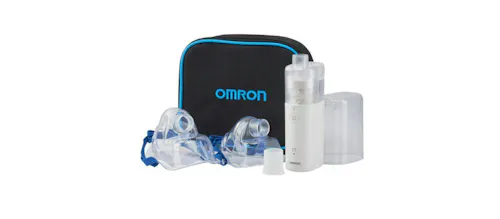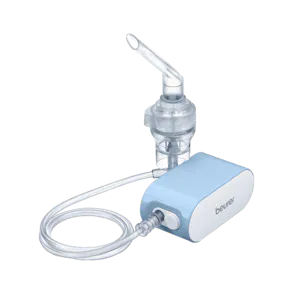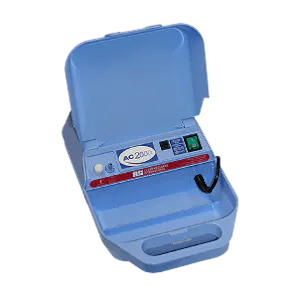Mesh nebulisers. Practically featherweights
Blog > Nebulisers > Portable Nebulisers >Philips InnoSpire Go Nebuliser > Omron MicroAir U100 Nebuliser
In this post we take a look at our two mesh nebulisers, the similarities and differences of the Philips InnoSpire Go and the Omron MicroAir U100.

Mesh technology
Traditionally nebulisers can be bulky and noisy which is not very convenient when you’re in the cinema or planning a nice day out. Mesh technology enables a nebuliser to be smaller, extremely portable and virtually silent. 1994 was the debut of the first portable model from Omron Nebulisers, the NE-U03. This used early mesh technology to give you the freedom to nebulise just about anywhere.This small metal plate has 1,000 microscopic holes through which your medication is pushed at speed to form a visible mist. Vibrating mesh technology allows your medication to penetrate quickly and deeply into your lungs.
Just how small is small?
The handset for InnoSpire Go weighs only 111 grams which is incredibly light but in its carry case with the mains cable it will be slightly heavier. Similarly, the handset for Omron U100 is 200 grams but that’s without its 2 AA batteries. Compared to a mains compressor at around 2kg they are practically featherweights and so tiny they will easily pop in your pocket or handbag.
What about speed?
The InnoSpire Go can, when working at its optimum performance, deliver 2.5ml of a bronchodilator in around 4 minutes and the flow rate for the U100 is about the same. Obviously this can vary depending on how well the devices have been looked after, where you are using them and the age of the batteries but you have to agree it’s pretty swift. Perfect if you’re having fun and don’t want to miss a minute. With a particle size of less than 5 microns for both nebulisers you can be confident your therapy will penetrate deep into your lungs right where you need it to be.
Virtually silent?
The U100 states its decibel level at around 20dB which is as quiet as someone whispering up close. Similarly the noise from the InnoSpire Go is hardly even a hum making them both ideal for use in the early hours when you don’t want to wake the family. They are so discreet you can use them anywhere without fear of embarrassment even at the theatre for example you wouldn’t have to leave your seat.
So far they are pretty similar, so how do you choose?
That’s a lifestyle choice and depends on your personal preference. What are your expectations? Realistically where do you travel and which model would you feel more comfortable with?
Portability
The InnoSpire Go has an internal lithium polymer battery. It’s a long life battery in that it can provide you with up to 30 treatments of 2.5ml of medication between each charge. Plenty of time to get off the beaten track or cover you for that long haul flight. There’s an LED display which alerts you if the battery is getting low so you won’t get caught out and it will recharge in 2 hours. If the batteries are low you can nebulise direct from the mains electricity supply and because it will operate from 110 to 240 volts you can plug in anywhere in the world. Philips Nebulisers, inspiring you to take that first step.
In contrast the U100 works from 2 AA batteries and if you choose good quality batteries they should provide about 4 hours of use. This still provides you with plenty of opportunity for multiple therapies and if your camping overnight there’s nothing to stop you popping an extra set of batteries in your pack. Standard AA batteries are readily available in most parts of the world but it would be wise to check before you travel. There is a mains adaptor as an optional extra which will work anywhere in Europe or where the voltage is 220 to 240. The mains adaptor is also useful if you’re nebulising at night and wish to save on batteries.
Cleaning and care
With any nebuliser cleaning is essential in order to obtain the maximum performance and ensure the longevity of the unit. Both come with concise instructions and there are videos on line to take you through it step by step.
The InnoSpire Go is the simplest of the two as the mesh is enclosed in the mouthpiece. It should be rinsed after each use, washed in warm soapy water daily and boiled in a pan for 10 minutes, just like an egg. Instead of boiling you could use an electric steam steriliser or the disinfectant recommended by Philips. As the mesh is enclosed in the mouthpiece replacement cost is more expensive than that for a mesh cap for the U100. The instructions for the U100 are similar and though the mesh is cheaper to replace it is slightly more exposed. People with manual dexterity problems may need help with cleaning and assembly.
And finally, cost
The InnoSpire Go purchased from us is currently £139 compared to the U100 at £95. However if you were to choose the optional mains cable or invested in a AA battery recharger for the U100 the price would be about the same. The warranty for the Innospire Go is less than the U100 and if used regularly the mesh on both devices has to be replaced every 12 months.
Dearer than a mains powered nebuliser maybe, but the freedom these devices can offer is worth it. Time and time again we hear stories from customers of how a portable nebuliser has opened up their world. Whether it’s to start at the beginning and access pulmonary rehab, enable them to get back to work or take a long awaited trip somewhere exotic you really don’t need to stay chained to the house. If you need to nebulise a more complex therapy regime such as steroids or antibiotics there’s a portable nebuliser for you too. Why not take a look at our website or better still give us a call we’re always happy to help.
Photo credits: Jenelle Ball, Rachael Gorjestani









